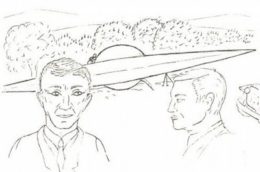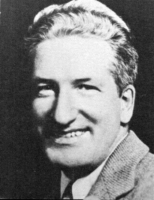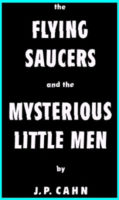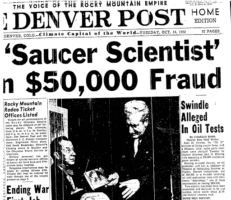By Charles Lear
 It often occurs among UFO enthusiasts that people will form a belief in a case and find it difficult to let go of that belief in spite of evidence that the case was more than likely a hoax. The alleged 1948 crash and retrieval of a flying disk near Aztec, New Mexico is a classic example. This case has spawned the well-known 1950 book by Frank Scully, “Behind the Flying Saucers”, two books that gave it new life, one in 1986 and one in 2011, and two extraordinary articles in True magazine that should serve as a model for investigative journalism.
It often occurs among UFO enthusiasts that people will form a belief in a case and find it difficult to let go of that belief in spite of evidence that the case was more than likely a hoax. The alleged 1948 crash and retrieval of a flying disk near Aztec, New Mexico is a classic example. This case has spawned the well-known 1950 book by Frank Scully, “Behind the Flying Saucers”, two books that gave it new life, one in 1986 and one in 2011, and two extraordinary articles in True magazine that should serve as a model for investigative journalism.
Things got rolling on March 8, 1950 with a lecture at the University of Denver on the subject of flying saucers. The lecturer spoke before a large group of students and remained anonymous for alleged security reasons. He was originally chosen to provide a Basic Science class studying critical thinking something to work with but the word got out and, due to popular demand, it was necessary to move the lecture to a larger hall. The man started with some background history, speculated that the craft were operated using magnetic propulsion and then mentioned that there had been four crashes and retrievals in America and a fifth in Africa. A local paper wrote an article about the lecture and the hunt was on for the lecturer’s identity. It was eventually discovered that the man in question was Silas P. Newton, who represented himself as a prominent geophysicist and businessman in the oil industry. He happened to be a friend of Frank Scully, who was a writer for Variety, and Scully realized that he had a good story on his hands. He talked with Newton who introduced him to a colleague who would be referred to only as “Dr. Gee” by Scully and the result was “Behind the Flying Saucers” published in September of that year. It was in this book that details of the Aztec crash and retrieval were made public to a wide audience and a case was born that refuses to die in spite of evidence that the event in question never happened.

According to the story told to Scully by Newton and “Dr. Gee”, the Air Force had tracked an object that had come to rest on a mesa near Aztec. A team of scientists was called in, headed by “Dr. Gee” and they came upon a disk that was 99 feet in diameter with all other dimensions divisible by 9 which, purportedly, had a special significance. After two days of “bombing” the craft with “Geiger counters, cosmic rays and other protective devices” it was considered safe to attempt to enter the craft. No door could be found but there was a small hole in a port window and a stick was poked through it that was used to push a pair of buttons that opened and revealed a door. On entering the craft, 16 bodies, 36 to 42 inches in length were discovered. The creatures looked like small humans, some with charred “chocolate” colored skin and were dressed in blue uniforms with buttons that one of the team described as looking “like the style of 1890.” “Dr. Gee” told Newton about this crash and two others, one of which was a small two-seater craft and made arrangements to get clearance for Newton to examine it in the laboratory where it was housed. By the time the clearance came through, the craft had been dismantled and all “Dr. Gee” had to show was some material he’d salvaged which included some small metal disks, gears, and a mysterious radio. Scully was told that “more than 150 tests had failed to break down the metal of the gears.”
The book is divided into 17 chapters with the crash retrievals described only in chapter twelve. The book begins with an account of the lecture, goes into some saucer history, presents some laughable statements on magnetism by Newton and “Dr. Gee” (such as Venus and Earth being held apart due to their positive poles facing each other) while puffing up their credentials, presents a decent summary of the then present knowledge of astronomy, an accurate review of the history of magnetism, and ends with a list of a staggering 143 news articles that, alone, makes the book a valuable resource for researchers. A thorough chapter-by-chapter summary can be found on the Southern Methodist University Department of Physics website. The book sold well and made some good money for Scully and his publisher but, as investigative journalist, John Philip Cahn would discover. Newton and “Dr. Gee” were also making money from the book indirectly and quite dishonestly.
 J.P. Cahn looked into the story for True magazine and published an article in 1952 titled, “The Flying Saucers and the Mysterious Little Men.” Cahn managed to get close to Scully who introduced him to Newton and Cahn would discover, on his own, that “Dr. Gee” was most likely an associate of Newton’s named Leo Gebauer. Newton presented himself as a scientist and prominent in the oil industry as President of the Newton Oil Company. Newton promoted this image by dressing well, staying in luxury suites and always driving a Cadillac. What Cahn discovered was that the base of operation for the company consisted of two small offices in Denver, Colorado connected by a waiting room. Newton claimed to have “rediscovered” the productive and profitable Rangely Oil Field in Colorado, but Cahn was informed by Richard D. Wright, an exploration superintendent with the California Company that this was “baloney.” The California Company was a subsidiary of Standard Oil of California and controlled many of the leases on the field. Wright described Newton coming out to the field with a “doodlebug outfit” that he claimed could find oil and that after criticizing the other workers that their geology was off he proved that his was far worse. A “doodlebug” was typically a secret device with alleged special oil detecting abilities that was used to lure gullible prospects (suckers) into investing in oil leases. Capitalizing on the popularity of the book, Newton claimed that oil gave off magnetic “lines of force” that could be detected by his new device, which happened to have been developed using alien technology.
J.P. Cahn looked into the story for True magazine and published an article in 1952 titled, “The Flying Saucers and the Mysterious Little Men.” Cahn managed to get close to Scully who introduced him to Newton and Cahn would discover, on his own, that “Dr. Gee” was most likely an associate of Newton’s named Leo Gebauer. Newton presented himself as a scientist and prominent in the oil industry as President of the Newton Oil Company. Newton promoted this image by dressing well, staying in luxury suites and always driving a Cadillac. What Cahn discovered was that the base of operation for the company consisted of two small offices in Denver, Colorado connected by a waiting room. Newton claimed to have “rediscovered” the productive and profitable Rangely Oil Field in Colorado, but Cahn was informed by Richard D. Wright, an exploration superintendent with the California Company that this was “baloney.” The California Company was a subsidiary of Standard Oil of California and controlled many of the leases on the field. Wright described Newton coming out to the field with a “doodlebug outfit” that he claimed could find oil and that after criticizing the other workers that their geology was off he proved that his was far worse. A “doodlebug” was typically a secret device with alleged special oil detecting abilities that was used to lure gullible prospects (suckers) into investing in oil leases. Capitalizing on the popularity of the book, Newton claimed that oil gave off magnetic “lines of force” that could be detected by his new device, which happened to have been developed using alien technology.
Cahn then looked deeper into Newton’s background and found charges of fraud against him dating back to 1931 but that he always managed to escape conviction. He then went about locating GeBauer and found that Newton had owed him some money for equipment he had built for him. He attempted to get both Scully and GeBauer to admit that he was, indeed “Dr. Gee” and despite being unsuccessful, remained convinced he had his man. Cahn’s boldest move was managing to palm and switch one of the discs claimed to be from the saucer that Newton had been displaying with one he’d had made. Newton claimed the metal had not melted at 10,000 degrees Fahrenheit but tests Cahn had done showed it to be cookware grade aluminum that melted at the normal temperature of around 1200 degrees. With Newton’s credibility blown, Cahn concluded his article by giving Scully the benefit of the doubt that he was merely gullible and not a party to the deception.
 Cahn’s article caused quite a stir and attracted more information regarding the nefarious doodlebug operation being run by Newton and GeBauer. This led to a 1956 follow up article in True that described Cahn’s efforts to track down someone who’d been defrauded by the pair and who’d be willing to press charges. He found that someone in the person of Herman Flader in Denver. Newton and GeBauer had taken over $230,000 from Flader and he filed charges just before the three year statute of limitations was up. Newton and GeBauer were arrested on October 14, 1952 and the trial was set for June 9, 1953. News of the charges attracted 11 civil suits against the pair that they attempted to settle by paying off as many victims as they could. After a postponement the pair were brought to trial on November 10, 1953 and were eventually convicted. They were granted probation provided they make restitution to Flader and pay court costs, which meant they had to come up with over $82,000 in cash and provide Flader with a percentage of their income until the full amount was paid. Newton began by selling over $14,000 of worthless uranium stock, for which he was charged but he managed to stay on probation without paying anyone anything and, somehow, avoided prison.
Cahn’s article caused quite a stir and attracted more information regarding the nefarious doodlebug operation being run by Newton and GeBauer. This led to a 1956 follow up article in True that described Cahn’s efforts to track down someone who’d been defrauded by the pair and who’d be willing to press charges. He found that someone in the person of Herman Flader in Denver. Newton and GeBauer had taken over $230,000 from Flader and he filed charges just before the three year statute of limitations was up. Newton and GeBauer were arrested on October 14, 1952 and the trial was set for June 9, 1953. News of the charges attracted 11 civil suits against the pair that they attempted to settle by paying off as many victims as they could. After a postponement the pair were brought to trial on November 10, 1953 and were eventually convicted. They were granted probation provided they make restitution to Flader and pay court costs, which meant they had to come up with over $82,000 in cash and provide Flader with a percentage of their income until the full amount was paid. Newton began by selling over $14,000 of worthless uranium stock, for which he was charged but he managed to stay on probation without paying anyone anything and, somehow, avoided prison.
Even with all this against it the Aztec case was brought back to life twice by researchers who stumbled upon it. In 1987, William Steinman and Wendell Stevens published “UFO Crash at Aztec” and in 2011 Scott Ramsey with co-authors, Suzanne Ramsey and Frank Thayer published, “The Aztec UFO Incident.” The book was published again in 2015 with additional information and the Ramseys appeared on many podcasts and talk shows. They made a passionate argument but the book relies on questionable witness testimony and glosses over Newton’s and GeBaur’s criminal activity. They did bring some interesting documents to light but many researchers remained unconvinced. Regardless, the fact that a pair of con men used a flying saucer story to promote their oil scams made for one of the more unique stories in UFO history.
So that’s where my frying pan went…